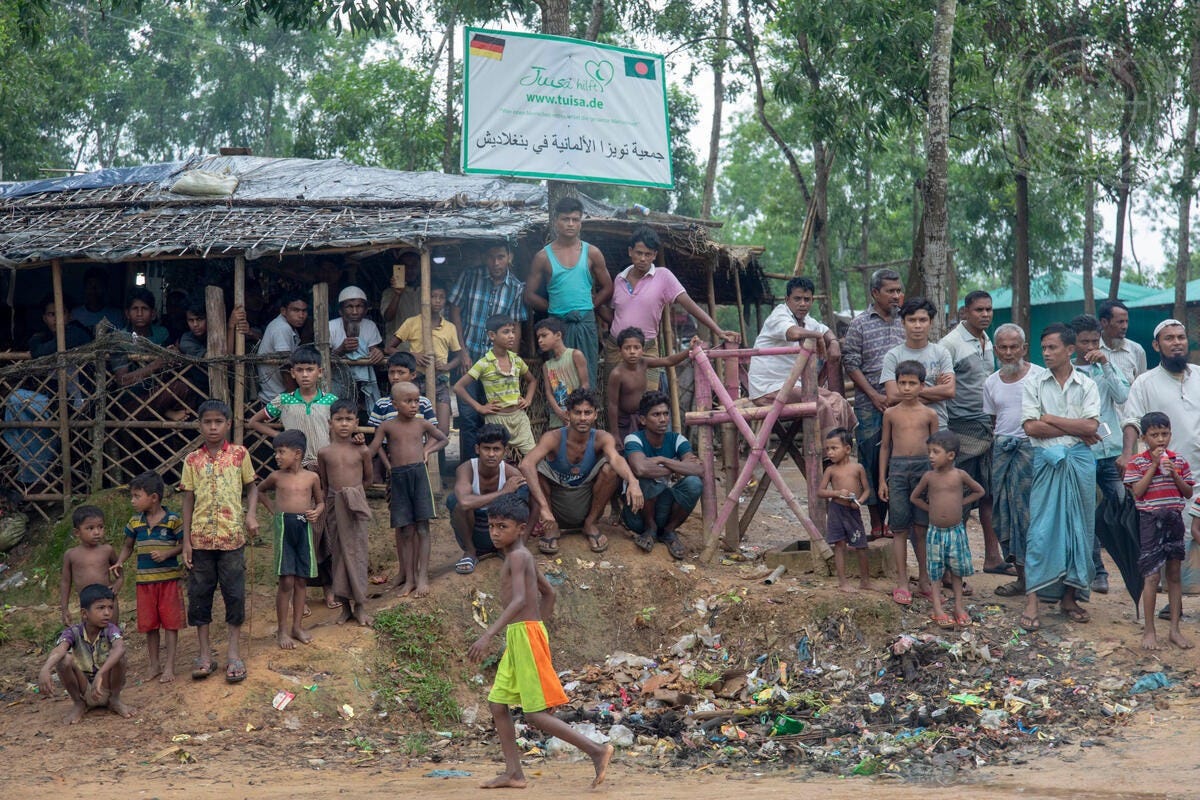The World’s Largest Refugee Camp Is About to Collapse
In Cox’s Bazar, nearly 1 million Rohingya refugees are about to face mass hunger and deprivation after U.S. funding vanished overnight.
It’s somewhat receded from memory, but in 2017 there was a genocide.
A militant group known as the Arakan Rohingya Salvation Army (ARSA) attacked several military outposts in Myanmar’s Rakhine State in an attempt to secure autonomy from the central government. ARSA was composed of Rohingya, an ethnic and religious minority that had long been subjected to discrimination and persecution by Myanmar’s military junta.
The military crackdown was swift and brutal—and did not discriminate between militants and civilians. In fact, the entire military strategy was premised on attacking the civilian population from which these militants emerged.
Entire villages were burned to the ground. Tens of thousands of people were murdered. And nearly 700,000 people were forcibly displaced within a matter of months. The Myanmar military designed a campaign of murder and mayhem to foment ethnic cleansing—one that most experts agree crossed the threshold into genocide.
A 2017 Human Rights Watch report captures the sheer brutality of this strategy:
On the morning of August 30, hundreds of uniformed Burmese soldiers and armed ethnic Rakhine villagers arrived in Tula Toli. Rohingya villagers, including residents of neighboring areas who had escaped to Tula Toli following attacks on their towns in previous days, fled to the wide bank of the river that borders the village on three sides. Many villagers told Human Rights Watch that the ethnic Rakhine local chairman had told them to gather at the beach, where he said they would be safe.
Security forces then surrounded the area, shooting at the gathered crowd and those attempting to flee. They separated men and women, holding the women and children under guard in shallow water while systematically shooting the men or hacking them to death with knives. Shawfika, 24, who saw her husband and father-in-law killed, said the killings on the beach went on for hours:
They just kept catching men, making them kneel down and killing them. Then they put their bodies on a pile. First they shot them, and if they were still alive, they were killed with machetes.… It took them one and a half hours to carry all the bodies.
By the afternoon, hundreds had been killed on the riverbank. Soldiers and Rakhine villagers burned the bodies in deep pits dug in the sand, in an apparent effort to destroy evidence of the killings.
Survivors described young children being pulled away from their mothers and killed—thrown into fires or the river, or beaten or knifed to death on the ground. Hassina Begum, 20, tried to hide her 1-year-old daughter, Sohaifa, under her headscarf, but a soldier noticed. “He took my daughter from me and threw her alive into the fire,” she said. “What could I do?… He had a knife in his hand and a rifle over his shoulder.”
The Burmese military was not brutal for brutality’s sake. There was a clear strategic intent driving this violence: the wholesale eviction of Rohingya from Myanmar. Most Rohingya live in Rakhine State, a province in the far western part of the country that borders Bangladesh. This strategy largely worked. Nearly 1 million Rohingya fled to Cox’s Bazar, a coastal province of Bangladesh that is now home to the world’s largest refugee camp.
Cox’s Bazar is a terrible place to be stranded—but still preferable to the genocide that awaited Rohingya on the other side of the border. Most people live in bamboo huts, cramped side by side, fenced in by Bangladeshi authorities who severely restrict the movement of refugees. Rohingya refugees have little prospect of gainful employment, and children have limited access to education. A “durable solution” to this refugee crisis has not materialized. There is little prospect that the Rohingya will return to Myanmar, now engulfed in a full-fledged civil war, and Bangladeshi authorities are highly reluctant to integrate the Rohingya into Bangladesh by granting work permits or freedom of movement.
In this vacuum, the United Nations and local and international NGOs are doing their best to provide these refugees with a modicum of support—food aid, shelter, medical services, and education. The aid provided since 2017 has never been commensurate with the needs on the ground in Cox’s Bazar, but it has kept hundreds of thousands of people alive.
Last year, the humanitarian agencies working in Cox’s Bazar received about $558 million to support their work. Of that, the United States committed about $300 million, over half the total funding for aid operations in the refugee camps. But now, that funding is frozen. Since the Trump administration halted foreign aid and dismantled USAID, aid operations in Cox’s Bazar have been significantly curtailed.
Now, with the US foreign aid freeze and shuttering of USAID operations, humanitarian officials are warning of an epic catastrophe about to unfold. The World Food warned that it would be forced to cut in half its food rations, from about $12.50 per person each month to about $6 per month. About 15% of children are already acutely malnourished in the camps, according to UNICEF. That number will likely soar. Children will begin to starve to death in front of aid workers who do not have the means to keep them alive.




